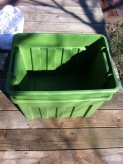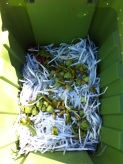Let’s Build a Worm Farm!
Posted: April 9, 2012 Filed under: Gardening Leave a commentMarch 22, 2012 by Soulsby Farm – A Very Small Farm
Step by Step Instructions on how to build your very own Worm Composting Bin. This is a 5 minute project. I completed it in 3 minutes with a cold beer in one hand. You can buy worms locally or from several sources online. I purchased 2lbs of Red Wigglers online for $29.99.
Here’s all you need:
2 Rubbermaid tubs (or cheap knock-off like these) or some old 5 gal buckets.
2 blocks (in this case a couple 2×4 pieces)
Shredded Paper (I find that worms like bill collection letters the best)
Kitchen Scraps (no meat or dairy products just veggies)
Crushed egg shells (provide calcium)
Cheerios and coffee grounds (with filter)
Worms (Red Wigglers or Eisenia foetida, are the best compost worms)
Drill (2 bits 1/8″ and 1/4″)
Step 1: Drill 1/8″ holes in the top (for oxygen) and 1/4″ holes in the bottom for worm juices. In 1 tub.
Step 2: Place a couple of 2×4′s (as spaces) in the bottom of the nu-drilled tub. Place Drilled tub on to the spacers, fill drilled tub about a third with shredded paper.
Step 3: Add crushed egg shells (great source of slow release calcium and can also act as a buffer, essentially helping to prevent excessively acidic conditions from developing.) and Cheerios (Worms like Cheerios).
Step 4: Add kitchen scraps (no meat, nothing greasy, no citrus,) veggie scraps and worms.
Step 5: Add some water. Worms like it moist and dark. Drill holes in top and leave em alone. In 90 Days you’ll have the best organic fertilizer and your plants will love you for it.
Interesting Worm Facts:
- There are over 4,000 species of earthworms.
- There are only about 6 species that are used for vermicomposting.
- Earthworms don’t have lungs, but instead breathe through their skin as long as it stays moist.
- Red Wigglers can consume up to 50% of their body weight per day
- Earthworms are hermaphrodites yet it still takes two worms to reproduce.
- Worms don’t have eyes , but are sensitive to light.
- Worms have no teeth for chewing food. They grind food in their gizzard by muscle action.
- A worm’s mouth is in the first anterior segment. There is a small protruding lip just over the mouth, called prostomium. When the worm is foraging, this lip is stretching out. The prostomium is for sensing food.
- You’ll be able to compost your kitchen scraps 10 times faster when compared to composting without them.
- One pound (16 ounces) of worms equals about 1,000 worms
- One pound of Red Wiggler worms can eat about half pound of organic matter every day.
Why should you start a Worm Farm?
- Remove excess waste from landfills & reduce your carbon footprint.
- Worms produce the best organic fertilizer
- Worm castings are five times richer in nutrients than the best topsoil and worm castings are pH neutral.
- Great treats for chickens and great for fishing.
- Worms make great friends. They just listen to you all day and never interrupt.
- If you’ve read this far, you’re crazy enough to do it.
What is Vermicomposting?
Worms and microorganisms convert organic materials to a beneficial soil amendment. The worms breakdown food scraps into nutrient rich compost.
Feed Worms:
- Vegetable scraps
- Fruit scraps and peels (mold/rot is fine)
- Bread and grains
- Coffee grounds (+ filters) and tea bags
- Crushed egg shells
- Napkins, paper towels
Don’t Feed Worms:
- Citrus
- Meats, fish
- Greasy foods
- Dairy products
- Twigs and branches
- Dog/cat feces, cat litter
You can leave the bin inside your house (there’s no smell) or you can build up a small army of worms and take over the world or just add them to your compost pile mid-summer. Or even better, start a Worm Farm (like Harry and Lloyd in ‘Dumb & Dumber‘) and call it I Got Worms.












